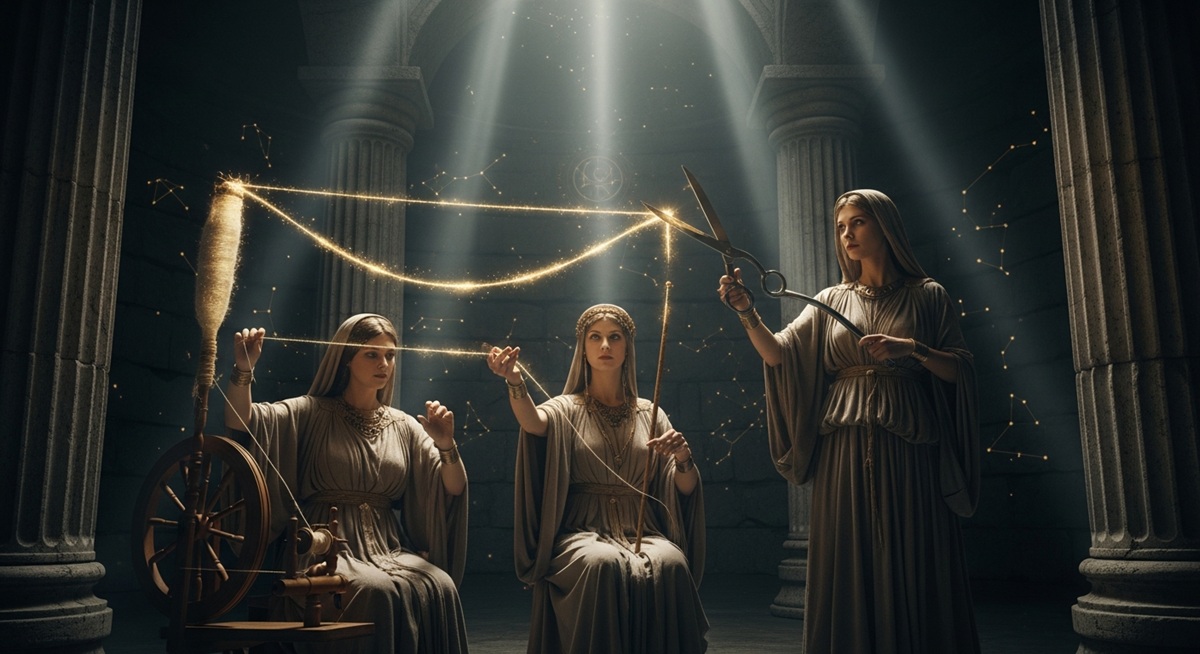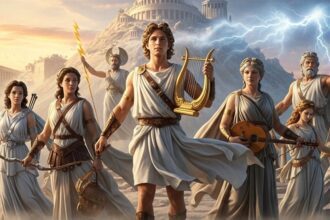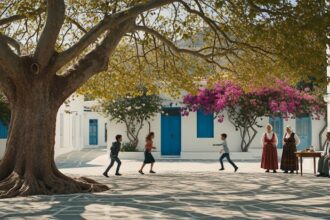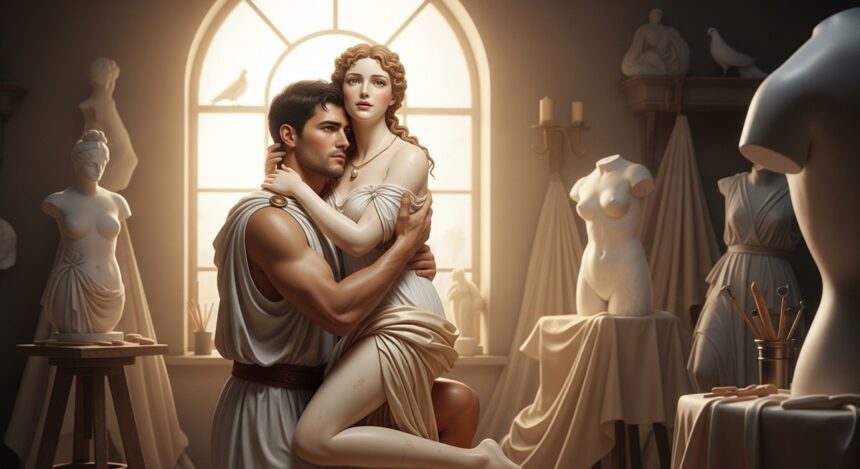Have you ever paused mid-stride, wondering why life’s roulette wheel seems rigged for some and merciless to others? One soul dances through decades of joy, while another flickers out like a candle in the wind, barely warmed by existence. Ancient minds grappled with these riddles too, peering into the cosmos for clues. And in the sun-drenched myths of Greece, they found their answer not in a single deity’s whim, but in the inexorable hands of three enigmatic sisters: the Moirae. These weren’t mere storybook figures; they were the cosmic architects, spinning, measuring, and snipping the very fabric of human fate. Even the thunderous Zeus, king of Olympus, bowed to their decree.
The Moirae: Guardians of the Inevitable
In the cradle of Western civilization, where olive groves whispered secrets to philosophers and warriors alike, the ancient Greeks didn’t just ponder fate—they personified it. The Moirae, often translated as the Fates, embodied the relentless rhythm of existence. Born from the primordial chaos (or, in some tales, from Night herself or Zeus and Themis), these deities weren’t flashy like Apollo’s golden chariot or Athena’s owl-eyed wisdom. No, the Moirae operated in shadows, their work silent yet supreme. They enforced a higher order, a universal law that even the gods couldn’t rewrite.
The Eternal Dance of Birth, Life, and Death

Picture this: A newborn’s first cry echoes through a humble hut in Athens, and already, the Moirae are at their looms. They don’t discriminate by birthright or heroism—kings and beggars alike fall under their gaze. This democratic grip on destiny fascinated the Greeks, who saw in the Moirae a mirror to their own unpredictable world of city-state rivalries, epic voyages, and philosophical debates. But what made these sisters so formidable? It wasn’t brute force or seductive charm; it was their unyielding impartiality. As Hesiod etched in his Theogony, the Moirae “allot to mortal men death at the fated hour.” No pleas, no bargains—just the cold click of shears.
Delve deeper, and the Moirae reveal themselves as puppeteers of the human drama. They orchestrated not just the endpoint but the entire arc: the joys of love, the sting of betrayal, the thrill of victory on blood-soaked battlefields. In a era plagued by plagues, wars, and the whims of tyrants, attributing life’s lottery to these goddesses of fate offered solace. It wasn’t random cruelty; it was design. Or was it? The Greeks left room for ambiguity, fueling endless tavern debates and temple offerings. Could a hero like Odysseus bend their will through cunning? Or was every twist in The Odyssey merely another loop in their spindle?
This tension between agency and inevitability echoes through history. Fast-forward to today, and psychologists coin terms like “locus of control,” while quantum physicists muse on multiverses. Yet, the Moirae remind us that some questions transcend time, urging us to cherish the thread we’re given.
The Triad of Terror: Meet the Three Moirae Sisters

Ah, but who were these spectral siblings, really? Early myths were coy, hinting at a singular Moira—a singular force, perhaps, to underscore fate’s unity. But as Greek lore evolved from oral epics to sculpted friezes, the number solidified: three. Why three? Symmetry, perhaps, mirroring the triune phases of life—beginning, middle, end—or echoing other divine trios like the Graces or Furies. Whatever the reason, this trio became iconic, each sister wielding a tool in the grand weaving of reality.
Their depictions varied wildly, a testament to the fluid nature of myth. Some artists, like those on Attic vases, painted them as lithe maidens with rosy cheeks and flowing robes, symbols of youthful promise. Others, drawing from Orphic mysteries, envisioned them as crones—hunched, wizened, eyes like polished obsidian, fingers gnarled from eons of toil. This duality wasn’t inconsistency; it was poetry. The Moirae were both cradle and grave, bloom and decay. Invariably, though, they clustered around a loom, distaff in hand, threads gleaming like starlit rivers. This spinning motif wasn’t whimsy; it rooted in the Indo-European reverence for weaving as metaphor for creation. As one fragment from Pindar notes, “The Moirae stand beside the throne of Zeus, golden-distaffed, measuring out the thread of life.”
Clotho: The Spinner Who Ignites the Spark
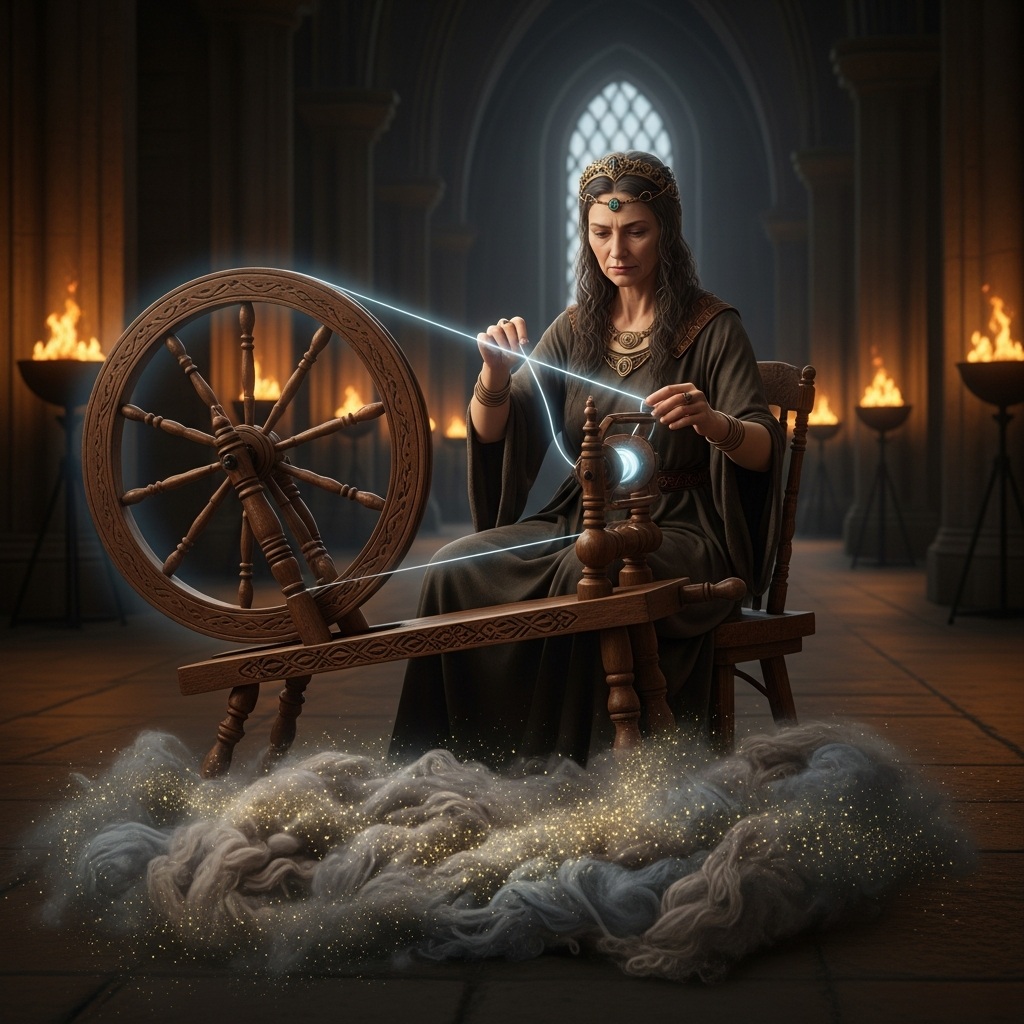
First among equals comes Clotho, the spinner. Her name evokes the whirl of the spindle—klōthō, to twist or wind. Imagine her in a cavernous hall, dimly lit by flickering braziers, her wheel humming like a distant beehive. From a chaotic skein of possibilities—flecked with gold for fortune, shadowed gray for sorrow—Clotho draws forth the raw thread of a soul’s journey. This isn’t idle craft; it’s inception. The moment her fingers tease out that filament, a life quickens: a farmer’s son in Thebes, destined for plow and hearth; a warrior-princess in Sparta, bound for glory and grief.
Homer, that blind bard whose verses still pulse through our veins, immortalized her in the Iliad: “From the day when his mother bore him, the Moirae spun for him his thread of life.” Clotho‘s touch set the warp—wealth or want, love or loneliness. Yet, her impartiality chills: No favoritism for the pious or the powerful. In vase paintings, she’s often shown with a distaff piled high, a visual pun on abundance she alone controls. Modern parallels? Think of geneticists mapping DNA strands, unaware they’re echoing Clotho‘s ancient rite.
Lachesis: The Measurer of Twists and Fortunes

Next strides Lachesis, the allotter—lachō, to draw lots. If Clotho births the thread, Lachesis charts its course. With a measuring rod or her shrewd gaze, she apportions length and texture: a long, silken strand for the blessed; a knotted, brittle one for the tested. But here’s where fate grows mischievous—she interlaces threads, binding strangers in matrimony, allies in battle, or foes in vendetta. That serendipitous encounter at a marketplace? Lachesis‘ knot. The betrayal by a trusted comrade? Her deliberate tangle.
Her domain explains the Greek obsession with oracles and omens; mortals craved glimpses of her blueprint. In Plato’s Republic, Lachesis sings of choices in the afterlife, souls selecting their next life’s lot under her watchful eye—a nod to free will’s fragile illusion. Artistically, she’s depicted apportioning with scales or a scroll, evoking justice’s blindfold. Today, in boardrooms and ballot boxes, we chase her favor through strategy and chance, oblivious to the loom’s hidden hand.
Atropos: The Cutter and the Final Verdict
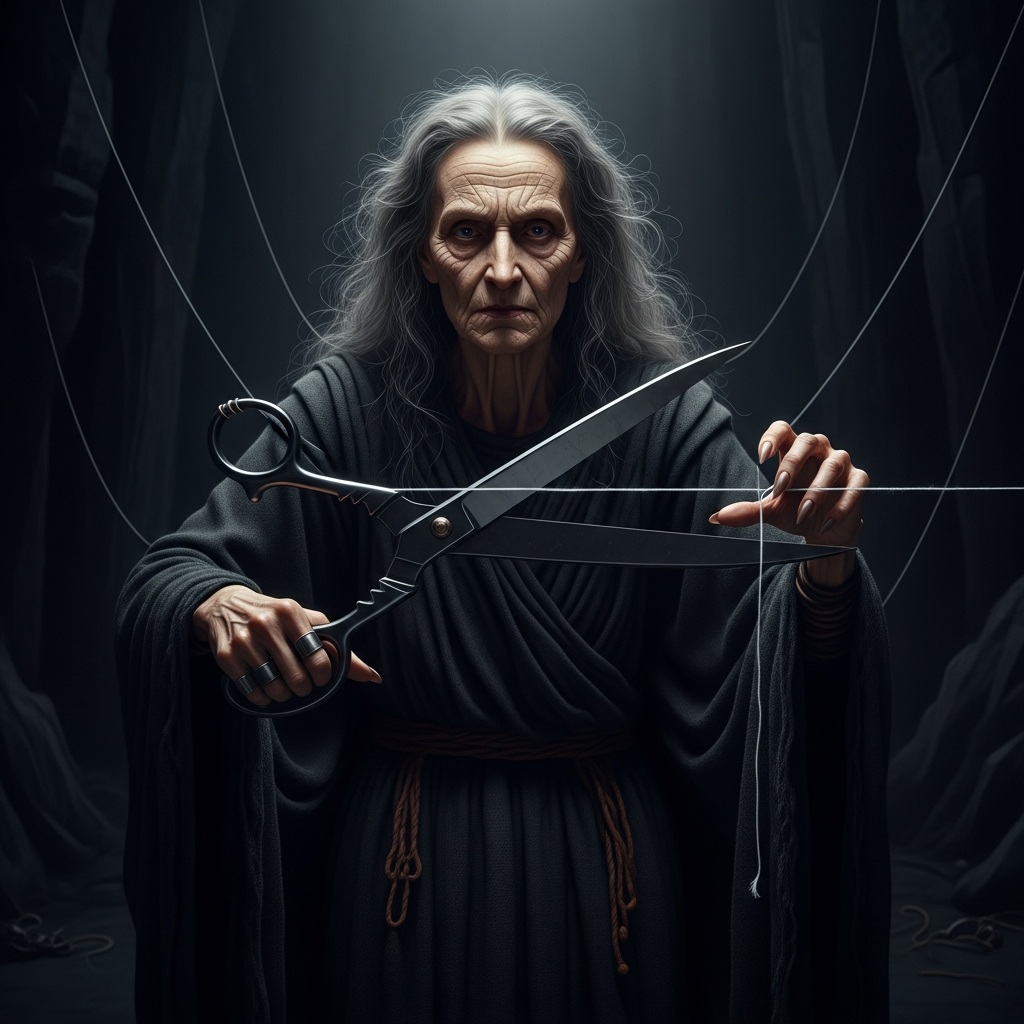
Last, and most dreaded, looms Atropos—the unturnable, a-trōpos. No beauty here; she’s the hag with shears, her blade honed on the whetstone of eternity. While her sisters craft with care, Atropos ends it all with a snip. Short threads for the untimely slain; languid ones stretched to old age’s hearth. Cruel? Nay, dutiful. As the Orphic Hymn implores: “O Atropos, inevitable and implacable, deliverer in misfortune, heed our pleas!” Yet pleas fall on deaf ears; her cut is law.
Myths brim with her shadow: Achilles, invulnerable save heel, felled by her decree; Hippolytus, dragged to doom despite innocence. Even gods quaked—Zeus once raged against a mortal’s fated death, only to relent, for the Moirae outranked him. In sculptures, her shears gleam ominously, a reminder that no armor avails against time’s edge. Echoes persist in our “grim reaper” folklore, a sanitized Atropos for softer sensibilities.
Zeus and the Moirae: Divine Power’s Ultimate Check

Now, the juiciest bit: Why did Zeus, hurling bolts from storm-cloud thrones, fear these thread-weavers? Greek polytheism thrived on hierarchy, yet the Moirae perched above it, primordial enforcers predating Olympus. Hesiod claims they were Zeus’s daughters, binding him too—a clever myth to reconcile supremacy with submission. In the Iliad, when Zeus weighs fates on golden scales, it’s the Moirae who tip them.
This dynamic fueled tragic theater: Heroes like Oedipus rail against prophecy, only to fulfill it, underscoring the Moirae‘s supremacy. Philosophers like the Stoics later embraced it, preaching acceptance of moira as cosmic harmony. Imagine Zeus at council, thunder dimmed, as Clotho spins a thread foretelling Troy’s fall. No veto power here; even gods are woven in.
Symbols of the Spinners: Looms, Threads, and Cosmic Webs
No discussion of the Moirae skips their arsenal. The spindle? A whorl of clay or bronze, humming fate’s song. Threads varied by hue—white for purity, black for woe—dyed in the vats of myth. Looms symbolized interconnectedness; one soul’s severing rippled through kin. Roman counterparts, the Parcae, borrowed wholesale, with Nona, Decima, and Morta echoing the trio.
Archaeology unearths clues: Votive spindles from Eleusinian rites, invoking the Moirae for bountiful births. In literature, Virgil’s Aeneid nods to them, threads binding Rome’s founding. These symbols transcend myth, inspiring Jungian archetypes of the collective unconscious.
Defying the Moirae: Mortal Will vs. Divine Design

Could one sway the goddesses of fate? Greeks whispered yes—through piety, sacrifice, or heroic virtue. Yet core belief held firm: Moira was ironclad. Sophocles’ choruses wail, “It is not possible to escape from what is destined.” Modern twists? Neuroscientists probe decision-making’s illusions, suggesting Lachesis lurks in synapses. Self-help gurus preach manifestation, a secular dodge of Atropos‘ shears. But as Camus pondered the absurd, perhaps embracing fate frees us.
Anecdotes abound: Sailors libating to the Moirae before voyages; brides weaving amulets against short threads. In essence, the question endures: Architects or accomplices in our stories?
The Moirae in Art, Literature, and Eternal Echoes
From Homer’s hexameters to Rossetti’s Pre-Raphaelite canvases, the Moirae captivate. Botticelli’s Birth of Venus subtly nods to Clotho‘s emergence. In opera, Wagner’s Norns weave Nordic kin. Contemporary novels like Madeline Miller’s Circe revive them, humanizing the divine. Even pop culture bows—The Fates in Hercules, threading Disney whimsy with dread.
This permeation underscores their archetype: Fate as weaver, life as fragile yarn.
The Lasting Loom: Moirae’s Shadow in Modern Life
Today, amid algorithms predicting our next click, the Moirae feel eerily prescient. Actuaries measure lifespans like Lachesis; grief counselors console Atropos‘ cuts. In a chaotic world—pandemics, climate woes—we crave their order. Yet they challenge: Live boldly, for the thread is finite.
So, next time fortune smiles or falters, glance skyward. The Moirae might just be chuckling, spindles turning.







